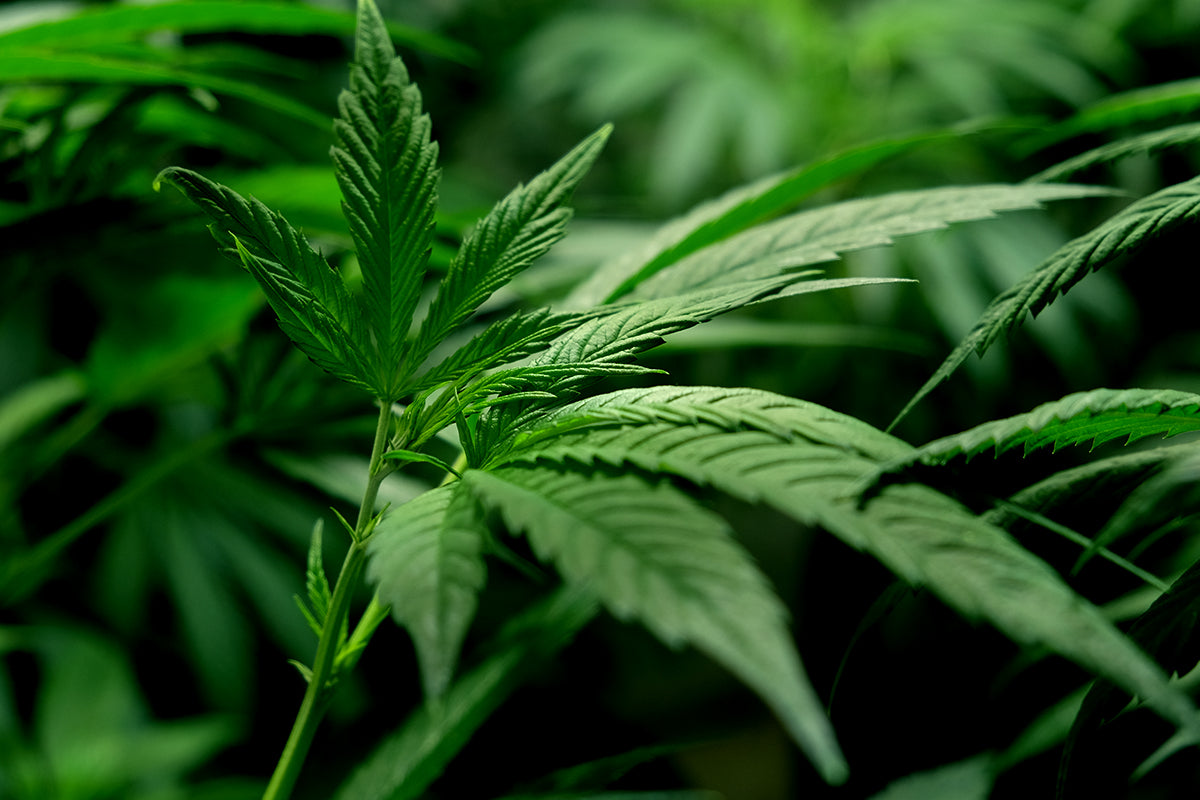In this article we will tell you how to best deal with the vegetative phase of cannabis. Many believe that this period of growth is unimportant but this is not the case at all. Have you ever seen a cannabis field with incredible flowers?
If you have seen them it is because the vegetative phase was carried out scrupulously, following very important parameters for the cultivation of marijuana. Read the whole article to find out how to grow cannabis correctly, the tricks and secrets to best deal with your harvest. Specifically we will talk about:
- What are the most important factors?
- The substrate
- The nutrients
- The light
- Irrigation
The vegetative phase is the moment in which the Cannabis plant goes from being a slender, very delicate-looking plant to appearing like a real tree. The seedling has just emerged from the seed, which has opened to reveal a small leafy shoot , which appears truly defenseless.
The plant grows and becomes stronger, filling with increasingly larger leaves, which will allow it to absorb as much light as possible during photosynthesis . The stem becomes more robust and fills with hairs and the sprout of just a couple of weeks before is just a memory.
Many novice growers think that the vegetative phase is less important than flowering, but they are wrong. The growth path of the plant is a cycle, and if one of its phases did not go as expected, the subsequent ones will inevitably be affected as well.
A plant that has had a bumpy growth develops much less and, consequently, will not produce the impressive harvests it could have given.
What are the most important factors?
The success of the growth phase of a Cannabis plant is linked to the stability of some parameters : it is important that the soil in which the roots develop is the most suitable for the plant.
That the light variations are constant, that the plants have enough oxygen and that water and all adequate nutrients are provided.
It is therefore necessary to constantly keep these factors under control . To give an example of indoor cultivation, if there was a lack of oxygen inside the cultivation room, because the extraction of air is insufficient or absent, the growth potential of the plants would be affected.
The substrate
The substrate is very important, because it is the place where the roots of the plant are born and develop, fundamental for its existence and growth.
Different substrates can offer different growth rates. The most common are earth , coconut and water . There is no absolute best, each has its own qualities, strengths and weaknesses.
The soil allows rapid growth only if it is adequately aerated and has a light structure: the roots need oxygen and develop better when they grow in a light and airy substrate.
For example, if the earth has been compacted it will contain less, with major consequences on the development of the plant. The advantage of growing your plant in potting soil is that you can delay the use of liquid nutrients.
The soil contains many nutrients and this allows you not to add liquid foods so soon. Getting off to a good start is key, so potting soil is the perfect substrate for beginner growers .
Coconut is an even more aerated growing medium . It guarantees an excellent start, because the roots develop very quickly thanks to the abundance of oxygen contained in the coconut fibres.
As a result, the plant will be stronger and grow faster.
The drawback of coconut is that it contains no nutrients, so you have to start administering liquid nutrients to the plant very early.
It's rare, but it can happen. In this case it will be necessary to rinse the substrate , giving the plant more water than necessary, so that the unabsorbed water "rinses" the coconut fibers.
Coconut therefore, while not difficult to use, is not recommended for inexperienced growers .
Using water as a substrate, i.e. growing Cannabis hydroponically , allows for very fast growth, but the stakes are high.
It is a very laborious system, which requires the use of many electrical devices, which continually expose the plants to the risk of breakdowns or blackouts.
The water in which the roots are immersed makes them develop very quickly, thanks to the large quantity of oxygen contained in it, but you have to be very careful.
If you're a beginner, it's best to avoid it.
The nutrients
During the growth period, plants need to receive many nutrients, especially nitrogen and potassium .
It's easy to notice if you're doing something wrong: if they have a nitrogen or potassium deficiency, plants yellow quickly.
If you use soil, this phase will go smoothly, because the soil suitable for growing Cannabis already contains enough nutrients for three/four weeks.
There is therefore no need to add fertilizers until the flowering period.
The larger the plant becomes, the greater the fertilizer requirement ; it may happen that at a certain point the plant shows a lack of nutrients through the aforementioned yellow spots.
The dosage of fertilized water will have to be increased, or you will have to administer nutrients more frequently.
The light
As for indoor cultivation, most growers are used to subjecting their Cannabis plants to a photoperiod of 18 hours of light and 6 hours of darkness.
Using HID lamps controlled by a timer. Using a timer is essential, because an irregular photoperiod causes great stress to the plants, which would no longer have a way of understanding when to grow and when to flower, with the risk of causing them to become hermaphrodites.
Alternation is very important, because light and darkness influence the life cycle of the plant .
Photosynthesis occurs during daylight hours : through chlorophyll the plant absorbs light and converts light energy into chemical energy.
On the contrary, during the hours of darkness the plant only carries out cellular respiration , taking in oxygen and releasing carbon dioxide, essential for the cell's metabolism.
The balance between these two processes is essential for the correct development of the plant.
When it comes to the type or quality of light for the growth phase, there are several options.
- 250, 400 and 600W metal halide lamps, low power CFLs;
- mixed lamps
- LED panels
- LEC or CHM lighting.
If there is no reason to accelerate the growth process, it is better to use energy saving lamps such as 250W CFLs, which are cold white light lamps , which do not produce heat and significantly reduce expenses.
If, however, we are in a hurry to grow them and want to save time in the growth phase, we will use HM white light bulbs with a power of 400W – 600W. These bulbs speed up the growth process but produce more heat.
You can also use mixed HPS bulbs of 400W – 600W, which combine the spectrums necessary for the growth and flowering of marijuana plants.
It will not be necessary to replace the lamp to bring the plant into flowering, but it will simply be necessary to change the photoperiod, with 12 hours of light and 12 hours of darkness.
The more powerful the light, the more heat it produces.
This is an aspect that should not be underestimated, because plants must live between 22 and 26 degrees during the hours of light , and between 18 and 22 degrees during the hours of darkness .
You will therefore need to pay close attention to the temperature and equip yourself with a good ventilation and extraction system or, vice versa, using heating or air conditioning.
If your growing environment is very dry, you may also need a humidifier; in the growth phase, it is recommended that the relative humidity values are within 60% / 70%.
Irrigation
The water requirement proportionally follows the growth of the plant , and increases as its size increases.
The amount and frequency of watering increases as the weeks pass. It is very important to be vigilant and respond to this increasing demand for water, especially in coco crops.
The ideal irrigation water temperature should be around 22 degrees .
Checking the pH (coefficient that indicates the acidity or alkalinity of the water) and CE (electro-conductivity or level of dissolved salts) of the irrigation water are factors to consider, because the best assimilation of the plant's nutrients depends on them .
The recommended pH of irrigation water for a marijuana grow in soil is between 6 and 6.8. The EC of the water should be around 0.4-1.2 milliSiemens (depending on the type of soil used and the amount of fertilizer it contains).
In coco and hydroponics we will use a lower pH, around 5.5-6 and a slightly higher EC, between 1.4 and 1.6.
Marijuana is a plant that prefers abundant , but not too frequent, watering. An excellent way to water Cannabis plants is to add water to the lower parts of its substrate . In this way it will be possible to control the water needs of the plants more precisely.
An easy way to do this involves placing the pots in a container full of water, so that the water is absorbed and pushed upwards, where the roots will have the task of assimilating it.
The roots of plants absorb water according to the principle of osmosis : they constantly seek a balance between the quantity of water contained in the roots and that present in the external substrate.
Once equilibrium is reached, the plants stop the absorption process . Watering the plants from the bottom stimulates the roots to grow more and develop downwards , in search of water, promoting much healthier development.
If the article was of interest to you, share it on social media with the rest of the Community, every single share helps us support our blog and keep you 360° informed on the world of Cannabis.
You might also be interested in:











